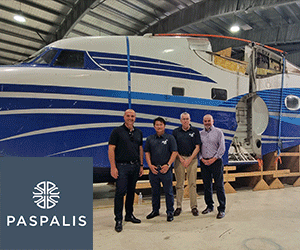1MG FlippingBooks
Canberra – Australia’s Innovation Capital
By Andrew James Barr
Only by positioning innovation at the heart of economies can it be achieved in a meaningful, widespread way. Canberra, with its wealth of institutions and performance belying its size, is a strong example of how this can be done.

Post-COVID-19, smart, forward-looking jurisdictions are taking the time to reflect on what the future of the global economy looks like and how they can rebuild to be in the best position for success. Though devastating in scale for both humanity and the economy, COVID-19 created an opportunity for economic renewal not seen since the end of World War II. For many jurisdictions, it is an opportunity to reshape their economies for the 21st century, with innovation at the core.
Many jurisdictions have been acting on the task of economic renewal for a long time. Sadly, many more have continued to rely on economies grounded in the past. The attitude of “if it ain’t broke, don’t fix it” is all too common. Such inaction has led to anaemic economic growth, inefficiency and stagnant wages. If continued, it will widen the gulf between the hand-sitting jurisdictions that are struggling to attract and retain talent to build their knowledge economies, and those jurisdictions that moved quickly to foster innovation and are now benefiting from a virtuous cycle of creativity, investment and growth.
There are many jurisdictions around the world known for their success in innovation. In 2019, the World Economic Forum listed the global megacities of New York, Tokyo and London among them. Elsewhere, places such as Singapore, Tel Aviv and Los Angeles have been outperforming their global peers for some time. But success in innovation is not just about adding up the number of “unicorn” companies (startups valued at over US$1 billion), nor is it a matter of measuring overall economic growth. There are plenty of jurisdictions benefiting from strong growth today in sectors that simply won’t exist tomorrow.
Success in innovation is about looking at how businesses across all sectors of an economy are performing against their global peers. It’s about encouraging people to think differently and take risks. And, importantly, it’s about creating a place where people want to live, work, raise a family and build a life, ensuring a cycle of growth and reinvestment as those who succeed invest their time, expertise and capital into new ventures.
Thinking differently is what creates new ideas and new businesses. Being competitive in a global environment is what keeps companies strong. And being a place where people want to live, work and raise a family ensures a cycle of growth and reinvestment as those who succeed invest their time, expertise and capital into new ventures.
In the Australian Capital Territory, the question of how to do these things simultaneously has been at the heart of the government’s thinking for more than a decade. With a population of nearly 430,000 and gross state product of around $42 billion, Canberra is a small city by global standards, but when it comes to innovation, we regularly outperform our peers on a per-capita basis across a number of important metrics.
Canberra had 1.9 patents registered per 10,000 people in 2018, compared to the Australian average of 1.1 and the next most prolific state or territory, New South Wales, at 1.4. In 2018-19, we also had the largest service-exports sector relative to population with around $54 million worth of exports per 10,000 people – more than 40 per cent higher than the national average.
Numerous factors have been central to this success:
- maintaining a focus on attracting the best and brightest minds;
- creating an innovation ecosystem where companies have access to knowledge and expertise;
- ensuring new ventures have access to ready capital, including through government- backed investment; and
- taking a medium-to-long-term approach to developing Canberra’s economy that transcends the cycle of creation and destruction caused by squabbling between opposing ideologies.
Key to the ACT government’s approach to fostering innovation has been creating a city in which people want to live. Canberra is a knowledge economy and the ability to attract the best and brightest minds is paramount. Our best resources will be found not in the ground but in our universities, research labs and technology parks. In that respect, the idea of Canberra as a society and not just an economy has been a core part of our thinking. That means citizens having access to affordable housing that doesn’t necessitate a two-hour daily commute. It means access to world class schools and universities. It means access to high quality, affordable medical care when and where you need it, as well as bushland, parkland and urban open space. These are the things people regard as prerequisites for a full and happy life, and they’re the things we have focused on delivering.
On the commercial side, we have invested heavily in building an innovation ecosystem that provides access to programs and support, and brings together people from all areas of business – including, importantly, founders and investors. Early on, we established the Canberra Innovation Network (CBRIN) as an independent body to focus solely on building this ecosystem. This has proven to be a huge success.
In 1997, the Canberra Business Development Fund was established, followed by the Australian National University–MTAA Super Venture Capital Fund in 2004 and Significant Capital Ventures in 2016. Since 2008, we have addressed market failure at the pre-commercialisation stage by supporting Canberra’s start-ups and developing a pipeline of investable companies through the Innovation Connect program. More recently, the government invested $9.75 million over three years to implement the Priority Investment Program, which focuses on sector development by co-investing in stimulus and innovation infrastructure projects across key sectors. Its emphasis is on the local tertiary education and research sector and its specialisations and growth building assets, which are seen as the primary driver of long-term wealth creation and jobs in Canberra.
In 2018–19, $5.2 million in funding went to five projects in the space, agri-technology, cybersecurity and renewable-energy sectors. In 2019–20, a further $2 million was directed towards three projects in the space, biosecurity and biodiversity sectors. Having the highest payroll-tax threshold in Australia – the result of a two-decade tax-reform plan that began in 2012 – has also been important in bolstering Canberra’s economic foundations.
Business as usual will not be enough to generate the level of growth needed to return the global economy to its pre-virus state. Fortunately, there are many actions forward-looking governments can take during this time of economic rebuilding to position their economies for strong growth over the coming decades. Canberra has prioritised innovation for more than a decade, earning the title of Australia’s innovation capital. Now is the time for all levels of governments across the world to be thinking about how to position innovation at the heart of their economies, and everything that involves.
Andrew James Barr is Chief Minister of the Australian Capital Territory. He has been a Labor Party member in the ACT Legislative Assembly since April 2006.










